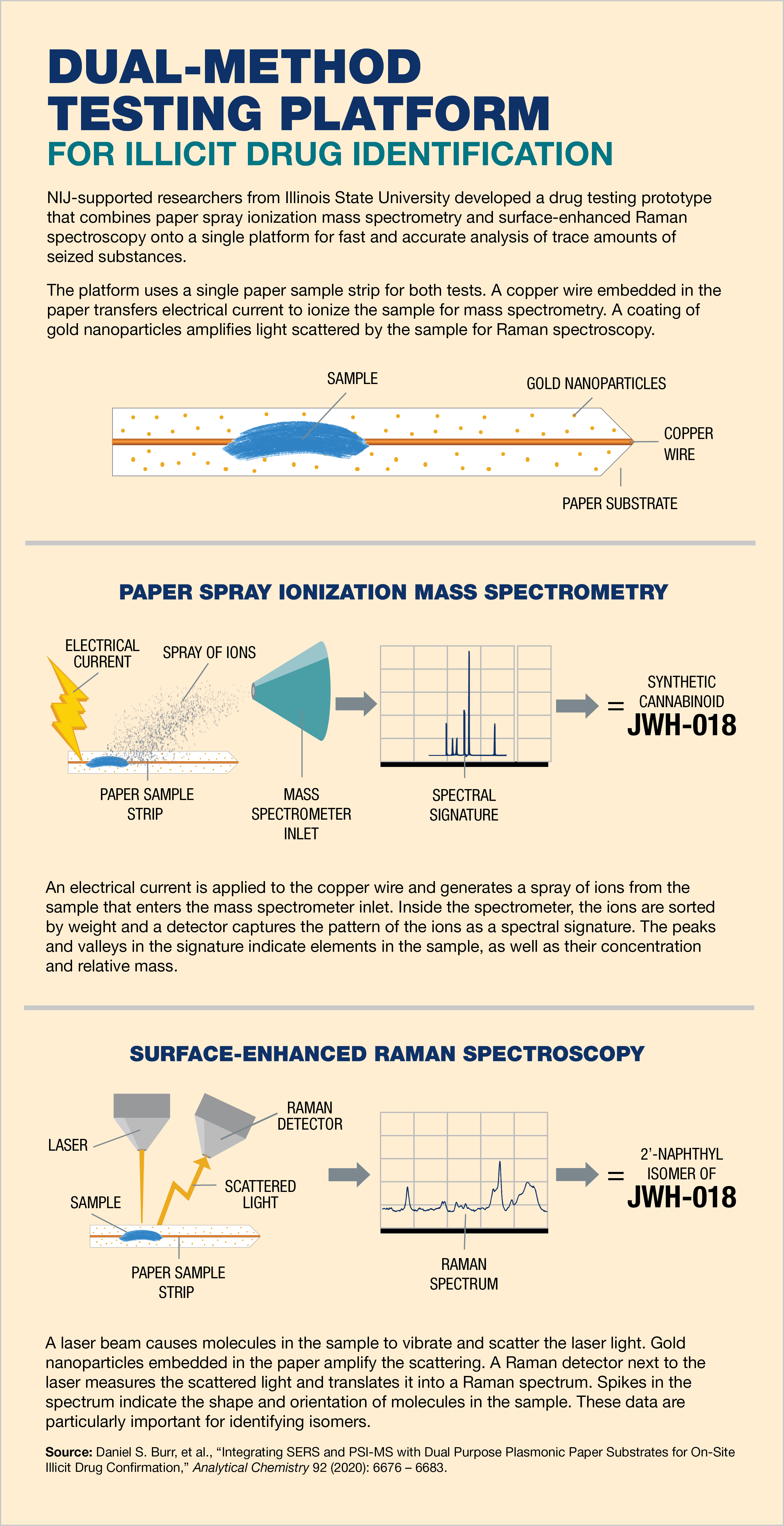Forensic laboratory backlogs can slow down analysis of seized drugs.[1] Field-based techniques, like colorimetric tests, are quick and easy to use but can produce false positives and unclear results.[2] Now, a National Institute of Justice-supported research team from Illinois State University has developed and tested a portable dual-method testing platform that could allow law enforcement officers to rapidly and accurately analyze seized drugs on site. The platform consists of a Raman spectroscopy module added to a commercially available mass spectrometry device. In a blind test of 500 samples, a prototype of the platform produced 99.8% accurate results.[3]
“This technology has the potential to assess the probative value of chemical evidence at the crime scene, requiring only pertinent samples to be sent to off-site laboratories for confirmation, easing the burden of casework and therefore reducing the magnitude of backlogged evidence,” said Christopher C. Mulligan, the project’s lead researcher. “By screening physical evidence at the crime scene, law enforcement personnel could rapidly determine whether a criminal investigation is needed.”
Two Tests on One Portable Device
Mass spectrometry and Raman spectroscopy are classified as Category A detection techniques by the Scientific Working Group for the Analysis of Seized Drugs.[4] Mass spectrometry is capable of discriminating individual drugs and other substances in a mixture, while Raman spectroscopy can be used to identify designer drug isomers (molecules with the same formula but a different shape). Both techniques are highly selective, require little to no sample preparation, and are easy to administer. The integration of two independent, validated techniques onto a single platform would, if the device becomes commercially available, meet the Scientific Working Group for the Analysis of Seized Drugs’ two-tiered identification guidelines for court-admissible evidence.
For their platform, the researchers chose two specific methods of mass spectrometry and Raman spectroscopy that are suitable for analyzing very small amounts of seized evidence: Paper spray ionization mass spectrometry and surface-enhanced Raman spectroscopy.
Prototype Design
A portable mass spectrometry platform, FLIR System AI-MS 1.2, outfitted with a paper spray ionization mass spectrometry module and a surface-enhanced Raman spectroscopy module served as the base for the dual-method prototype. (In a previously National Institute of Justice-funded study, the Illinois State team showed that the paper spray ionization mass spectrometry system accurately identified trace amounts of common and emerging drug types from unprepared samples. The testing was completed by recent police academy graduates and high school students.)
Next, the researchers designed and tested a paper substrate that could be used for both analysis methods. They obtained the best results from a strip of Whatman filter paper coated with gold nanoparticles for surface-enhanced Raman spectroscopy placed in a 3-D printed plastic cartridge with an embedded copper wire for paper spray ionization mass spectrometry.
To analyze a drug sample, the researchers placed a small amount of the substance directly on the paper strip and loaded it into the plastic cartridge mounted on a movable stage beneath the paper spray ionization mass spectrometry and surface-enhanced Raman spectroscopy modules. First, an electrical current applied to the copper wire created an ionic spray of the sample for mass spectrometry measurement. Next, the cartridge would slide under the Raman spectroscopy laser for sample analysis.
Assessing Platform Performance
The researchers performed a blinded experiment to test the reliability of their dual-method platform. Five hundred paper strips with trace amounts (less than 200 nanograms) for positive drug controls and blank paper strips for negative controls were randomly assigned to be tested by student members of Mulligan’s research group over 25 days.
The team reported no false positives and a marginal false negative rate of 0.17% for the blinded experiment. At first, testers took an average of 6.84 minutes to test each sample, but eventually decreased their sample throughput time to 4.87 minutes after gaining more experience with the platform.
The researchers also performed isomer tests on authentic drug seizures, like crystal methamphetamine, in collaboration with local law enforcement practitioners. Results demonstrated that the platform was able to differentiate isomers of novel psychoactive substances.
What’s Next?
According to the researchers, results from prototype testing showed that their dual-method platform has the potential to modernize policing of drug-related crime and traffic violations. And if the platform’s test results prove to be admissible in court, the researchers say its use could lead to expedited criminal investigations, casework, judicial proceedings, and potential plea bargaining. The platform’s portability could also prove useful at correctional facilities and in rural communities as a rotating or shared resource for law enforcement.
The research team is investigating collaborations with industry for future commercialization. “Financial constraints will most likely be the determiner for successful commercialization and implementation,” said Mulligan. “With budgetary concerns affecting law enforcement and forensic agencies, this technology will have to be shown as financially viable.”
About this Article
The research described in this article was funded by NIJ grant 2017-R2-CX-0022, awarded to Illinois State University. This article is based on the grantee final report “Coupling Raman Spectroscopy with Ambient Sampling, Portable Mass Spectrometry for On-site, High-Throughput Evidence Confirmation on a Single Instrumental Platform” (March 2020) by Christopher C. Mulligan.
Researchers from Illinois State University have received two other NIJ grants related to research focused on analyzing evidence at the crime scene:
- Analytical Validation and Impact Assessment of On-Site Evidence Screening via Ambient Sampling, Portable Mass Spectrometry
- Accessing the Probative Value of Physical Evidence at Crimes Scenes with Ambient Mass Spectrometry and Portable Instrumentation


